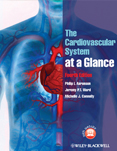-
1. What is the most likely diagnosis given the history?
Show Answer
This man has angina. This is a central chest tightness, or crushing sensation that is due to myocardial ischaemia. The pain of angina may radiate to one or both arms (more commonly the left), to the jaw, neck or back.
-
2. What risk factors (modifiable and non-modifiable) for coronary artery disease does this man have?
Show Answer
Modifiable: increased body mass index, sedentary (office worker), hypertension, hypercholesterolaemia, smoking, excessive alcohol intake (28 units/week is the maximum recommended intake for men). Non-modifiable: male gender.
-
3. What is amlodipine?
Show Answer
Amlodipine is a long-acting calcium-channel blocker (CCB) belonging to the dihydropyridine class which is used to treat hypertension and angina. It works by relaxing vascular smooth muscle, thus causing a reduction in peripheral vascular resistance, thereby lowering blood pressure. This reduction in peripheral vascular resistance is also thought to explain its efficacy against angina, because this would reduce the afterload against which the heart must pump, thus reducing myocardial oxygen demand.
-
4. What is simvastatin?
Show Answer
Simvastatin is a statin, a class of lipid-lowering drugs that inhibit HMG-CoA reductase, the enzyme responsible for the rate-limiting step in the synthesis of cholesterol in the liver.
-
5. What modifications would you make to this man’s existing therapies?
Show Answer
His elevated blood pressure reading suggests that his hypertension is not adequately controlled with the low dose of 5 mg/day amlodipine. However, it would be unwise to increase the dose of a long-term antihypertensive based on an isolated BP reading. This man should be given a dose of metoprolol (a β-blocker) and his antihypertensive should be changed to a β-blocker the following day. Simvastatin 20 mg/day is a low dose. In view of his strong risk factors for coronary artery disease, this can comfortably be doubled to 40 mg/day.
-
6. What long-term treatment should he receive for angina?
Show Answer
Most important are lifestyle modifications to reduce his cardiovascular risk factors. He should be encouraged to lose weight, engage in brisk daily exercise and be referred to a smoking cessation clinic. Anti-anginals such as β-blockers, which decrease myocardial oxygen demand, and drugs to halt the progression of his coronary artery disease are es-sential. He is already taking amlodipine for hypertension and he could continue to take this at an increased dose to treat his angina also. In terms of secondary prevention, he is already taking simvastatin, but the dose of this should be increased. He should be started on 75 mg/day aspirin, which has been shown to decrease mortality. To treat the symptoms of angina, he should be given a GTN spray for sublingual administration prior to any exertion, or to termi-nate an angina attack. He should be told that if the chest pain is not relieved 5 min after two puffs under the tongue, then he should administer a further two puffs. If this fails to resolve his symptoms, then he should be told to call an ambulance, as he could be suffering an acute coronary event.

